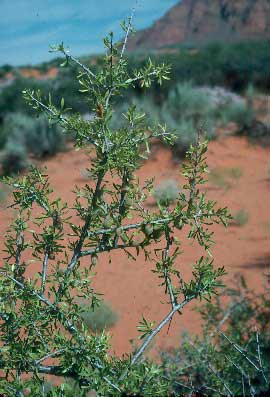Desert Peach

Common Name(s):
Desert Peach
Desert Almond
Scientific Name:
Prunus fasciculata (Torr.) Gray
Scientific Name Synonyms:
None known
Symbol:
PRFA
Description:
Life Span: Perennial
Origin: Native
Season: Deciduous
Growth Characteristics: A widely-branched shrub, growing up to 8 feet tall, with the average height being approximately 3 feet tall. It grows in clumps and thickets along the rocky slopes of the southern Great Basin. Desert peach flowers from March to May. Reproduction is mainly vegetative, but reproduction can occur from seed also.
Flowers/Inflorescence: Tiny white, non-showy, flowers that grow from the leaf axils.
Fruits/Seeds: Gray-green, almond-like fruits that are about 1/3 inch long and covered with a dark brown, fine hair. It generally resembles a small, fuzzy peach. A thin, dryish pulp surrounds a roughened stone-like seed.
Leaves: The small, somewhat narrow leaves are grouped in clusters and fascicled on short, lateral branchlets.
Stems: Branches are short, rigid, and sometimes spinescent. Gray bark.
Ecological Adaptions:
Desert peach is adapted to harsh, arid sites in the Great Basin and Mojave Desert, and is often found in the transitions from desert to oak woodland. It is not capable of withstanding the very arid and saline environment of the true desert. Typical sites include dry, warm foothills, dry streambeds, mountain slopes, mesas, alluvial terraces, and canyons. Most plants occur at elevations ranging from 5,000 to 6,500 feet.
Soils: Found on well-drained soils, most likely on soils that are coarse sandy, gravelly, or rocky in texture and exhibit little profile development.
Associated Species: Douglas rabbitbrush, green ephedra, desert gooseberry, spineless horsebrush, needlegrasses, and Indian ricegrass.
Uses and Management:
Desert peach is probably a seasonally important forage species on the dry ranges where it grows. Although plants are not highly productive, the foliage is moderately palatable. Leaf clusters are generally easily accessible due to the low, open growth habit characteristic of most plants. Livestock consume the foliage primarily in the spring and immediately after rainy periods. It is moderately palatable to sheep and goats during intervals of increased moisture availability.
Desert peach is a useful shrub for revegetating desert roadsides because of the ornamental value of its abundant, pale pink to rose-colored flowers, which typically appear much earlier than those of most associated shrub species.
The Pauites made a medicinal tea from the leaves and twigs of this shrub that was used to treat colds and rheumatism.

